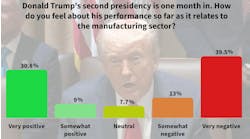Where Manufacturing’s Been—and Where It’s Going
The way products are made has changed quite a bit over the past few decades. I recently talked with some of my colleagues at Bright Machines about this very topic, and we realized that amongst us, we have over 75 years of experience in the manufacturing sector.
Mike Keogh, our CFO, is an industry veteran who has racked up more than 20 years working on manufacturing initiatives for companies such as Stanley Black & Decker, Apple, and Intel.
Our CMO, Caroline Pan, has over 25 years of experience across the manufacturing industry. She started as a design engineer at Ford Motor Co. and made her way into various marketing and strategy roles at Intel, Hewlett Packard and Honeywell. I have been around the manufacturing space since the early '90s. Before co-founding Bright Machines, I was responsible for worldwide operations at Flex, involving more than 150,000 employees across 100 sites.
Collectively, the three of us have witnessed several significant, transitional moments—driven by consumer behavior, production trends, trade wars and other factors. Experiencing those pivotal moments over the past 30 years has provided us with key insights—and has allowed us to see where the industry is headed as it continues to evolve.
What We've Seen: 1990s to 2010s
1. Outsourced manufacturing brings competitive advantage
In the late 1990s, global brands began a pivot to focus on the design and marketing of products while partnering with outside electronic manufacturing services (EMS) companies to handle production and assembly. Cell phone manufacturers, whose products first gained a foothold during this decade, were a prime example of companies getting out of the manufacturing game to devote resources toward other aspects of operations. This shift toward focusing on core competencies would move companies even further up the value chain in the years to come (more on this in a bit).
2. Supply chains become vertically integrated.
In the 2000s, the acquisition of materials and components used in electronics and other manufactured items was distributed from high-cost regions like Europe and the U.S. to low-cost regions like East Asia. As part of a larger trend in the distribution of supply chains, China alone nearly tripled its production of labor-intensive goods.
In other words, the assembly process isn't the only thing that moved. The supply chain did as well, encompassing all the metal and plastic parts, cables, capacitors, diodes and other components that would need to be assembled into a final product. Because the big EMS companies were in East Asia, it made sense for the component manufacturers to also be co-located nearby, and that region emerged as a vertically integrated, low-cost center for manufacturing.
Brands were comfortable with this development because they knew that customers could be well-served through large production runs of just a few different types of products. Over time, they became too comfortable, reducing or even eliminating capital expenditures across the globe and then shifting the work to EMS companies. Of course, this model relied on incredibly efficient supply chains based on just-in-time delivery—and for the better part of two decades, it mostly worked.
3. Innovative practices turn into incremental improvements that last until the practice is disrupted.
Starting in the 2010s, companies began to leverage original design manufacturers (ODMs) to help create a number of their products. More than just outsourcing manufacturing, companies realized they could outsource aspects of design in part or in whole, freeing themselves to focus on marketing and sales of high-value product lines. Near the end of the decade, this strategy was likely key for some companies seeing success in their business strategy.
A variety of personal computer manufacturers have continued to ride this strategy to great success with wildly popular and profitable entry-level laptops that are not only manufactured by third parties but also designed by them.
What's Changed
Today the manufacturing industry is in a state of rapid change. Several developments are impacting how what we’ve seen plays out and how successful the status quo can be in the future.
For starters, some major manufacturing hubs — think here of China or India — grew their own companies as their economies matured. These homegrown operations became tough competitors of the multinational brands whose manufacturing they managed, increasing competition for local workers and resources.
Meanwhile, just-in-time supply chains have been revealed to be more fragile than they first appeared. While the supply chain had been stress-tested in the past — notably during the economic meltdowns in 2000 and 2008 — the COVID-19 pandemic took it to a new level.
Many manufacturers were caught off guard, as large production centers weren't able to nimbly adjust to serve a customer base that began to have more particular preferences.
The result? Over the past 18 months, many people have had to wait months to get essential items ranging from cars to furniture — and we've all read about how holiday shoppers will likely be disappointed this year. This is to say nothing of the countless businesses that have been stymied by the shortage of silicon chips due to severe disruptions in the supply chain.
What's Next
Emerging technologies are giving almost completely new shape to the next generation of manufacturing, creating new opportunities for how and where manufacturing occurs.
My colleagues and I are working with one of the most promising innovations transforming the factory floor: intelligent automation. This software-based, modular approach to assembly makes it easier for manufacturers to have a smaller and more flexible footprint, avoid labor shortages, and make work easier and more interesting for human workers.
Because of this intelligent automation, we’re seeing a huge shift in what we’ve previously seen in the manufacturing industry:
1. Serving local buying habits provides competitive advantage
Intelligent automation can help make it less expensive to build smaller manufacturing centers closer to the end customer. This makes it possible to pivot to new products more quickly and rebalance supply based on local market demand.
2. Nimble supply chains are a response to serving local demand
In order for global manufacturers to better serve their customers around the world, they most likely will need to have multiple factories, which in turn will have regionalized supply chains tailored to serve them. Having factory capacity distributed across the globe also helps ensure manufacturers have protection in case of a global shock to the system. The idea here is to have plenty of built-in redundancy and no single point of failure.
Beyond resiliency, these nimble supply chains allow manufacturers to better serve their customers. This is particularly important given recent research that found that more than 50% of consumers said they prefer customized purchases, with the majority indicating they'd be willing to pay more for a product that is tailored to their preferences.
3. Data is the next logical step for continuous improvement
It used to be that outsourcing manufacturing, and even design, gave organizations a competitive advantage. Now, better data, digitized operations and intelligent automation are critical success factors. As production lines run, manufacturers constantly get information from the line in real-time — information they can use to their advantage.
The Future is Bright
Talking to customers always reminds us why we chose to make a career in this industry. Of course, there will always be disruptions and challenges, but these lead to innovation — and that's where things get exciting. The best way for the industry to capitalize on the next generation of innovation is by embracing factory digitization. Now that we are accomplishing this exciting step, my colleagues and I can't wait to work on what's next for manufacturing.
Tzahi Rodrig is chief operating officer and co-founder, Bright Machines.




